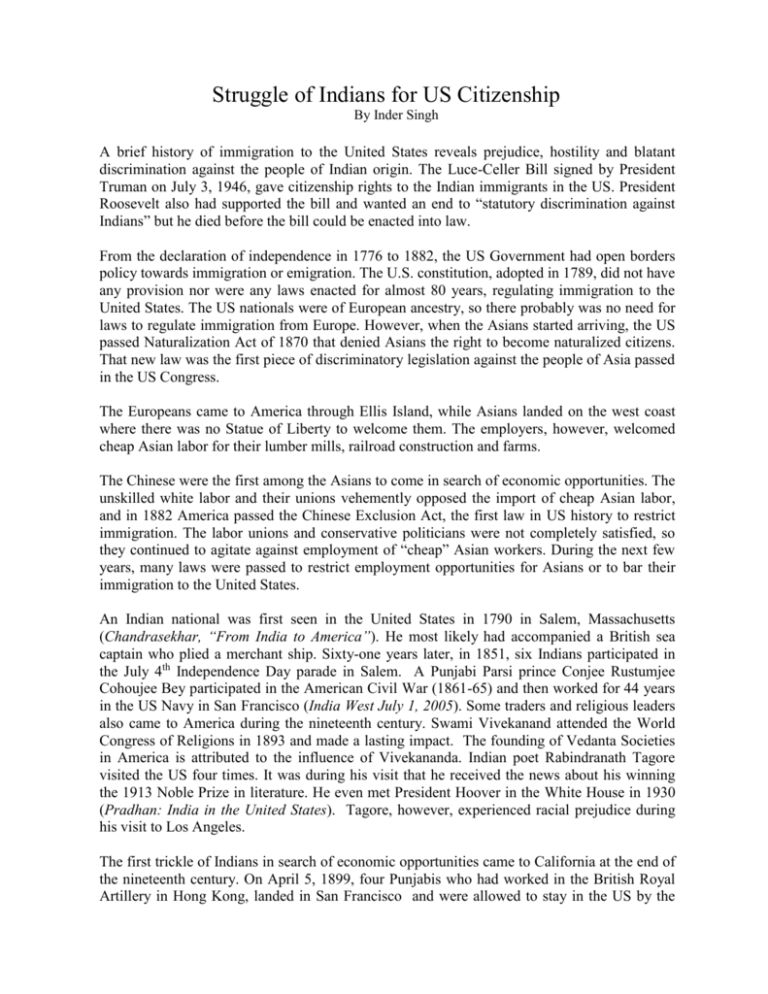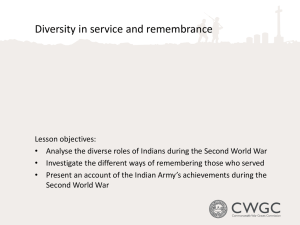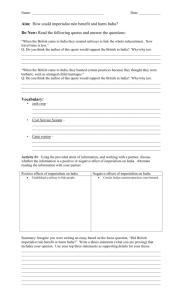Struggle of Indians for US Citizenship
advertisement

Struggle of Indians for US Citizenship By Inder Singh A brief history of immigration to the United States reveals prejudice, hostility and blatant discrimination against the people of Indian origin. The Luce-Celler Bill signed by President Truman on July 3, 1946, gave citizenship rights to the Indian immigrants in the US. President Roosevelt also had supported the bill and wanted an end to “statutory discrimination against Indians” but he died before the bill could be enacted into law. From the declaration of independence in 1776 to 1882, the US Government had open borders policy towards immigration or emigration. The U.S. constitution, adopted in 1789, did not have any provision nor were any laws enacted for almost 80 years, regulating immigration to the United States. The US nationals were of European ancestry, so there probably was no need for laws to regulate immigration from Europe. However, when the Asians started arriving, the US passed Naturalization Act of 1870 that denied Asians the right to become naturalized citizens. That new law was the first piece of discriminatory legislation against the people of Asia passed in the US Congress. The Europeans came to America through Ellis Island, while Asians landed on the west coast where there was no Statue of Liberty to welcome them. The employers, however, welcomed cheap Asian labor for their lumber mills, railroad construction and farms. The Chinese were the first among the Asians to come in search of economic opportunities. The unskilled white labor and their unions vehemently opposed the import of cheap Asian labor, and in 1882 America passed the Chinese Exclusion Act, the first law in US history to restrict immigration. The labor unions and conservative politicians were not completely satisfied, so they continued to agitate against employment of “cheap” Asian workers. During the next few years, many laws were passed to restrict employment opportunities for Asians or to bar their immigration to the United States. An Indian national was first seen in the United States in 1790 in Salem, Massachusetts (Chandrasekhar, “From India to America”). He most likely had accompanied a British sea captain who plied a merchant ship. Sixty-one years later, in 1851, six Indians participated in the July 4th Independence Day parade in Salem. A Punjabi Parsi prince Conjee Rustumjee Cohoujee Bey participated in the American Civil War (1861-65) and then worked for 44 years in the US Navy in San Francisco (India West July 1, 2005). Some traders and religious leaders also came to America during the nineteenth century. Swami Vivekanand attended the World Congress of Religions in 1893 and made a lasting impact. The founding of Vedanta Societies in America is attributed to the influence of Vivekananda. Indian poet Rabindranath Tagore visited the US four times. It was during his visit that he received the news about his winning the 1913 Noble Prize in literature. He even met President Hoover in the White House in 1930 (Pradhan: India in the United States). Tagore, however, experienced racial prejudice during his visit to Los Angeles. The first trickle of Indians in search of economic opportunities came to California at the end of the nineteenth century. On April 5, 1899, four Punjabis who had worked in the British Royal Artillery in Hong Kong, landed in San Francisco and were allowed to stay in the US by the Immigration Service (UC Berkley website). The grant of permission gave the signal to others to follow those four pioneers. In 1897, Queen Victoria of England, the then Empress of India, included a Sikh regiment from the Indian Army for her diamond jubilee celebration in London. On their return journey to India, the Sikh soldiers traveled via Canada. They were fascinated with the potential for farming opportunities in this far-away land and dreamt of returning after retirement from the army. The famine of 1899-1900 devastated the state of Punjab. Drought conditions of 1905-07 made living a virtual hell forcing people to think of leaving their homeland. Canada and the United States of America, though half a world apart, were strong and attractive magnets for Punjabis to emigrate. India and Canada were both British dominions, so there was no need for visa to travel to Canada. Thus Canada became the destination of Punjabi immigrants who quickly found jobs in lumber mills. The new immigrants were hard working and accepted lower wages, so some Canadian companies publicized the economic and job opportunities to entice more cheap labor from India. During the first few years, about 2000 immigrants, mostly Punjabi farmers and laborers, were permitted to come annually. As the number of immigrants increased, the locals felt threatened by labor competition from the hardy, low paid and adventurous Punjabis. Fear of labor competition led to racial antagonism and demands for exclusionary laws from Asian workers. In 1909, severe immigration restrictions virtually ended legal Indian immigration to Canada. By 1907, Indian immigrants saw the doors closing on them in Canada while America had abundance of jobs in the lumber industry and building of railroads. There was plenty of land to farm throughout the Sacramento, San Joaquin and Imperial valleys of California. Also, there were no restrictions in crossing the border between Canada and the United States, so Indians started coming to the US. Those Indians, who had planned to come to Canada, also decided to emigrate to the US. Indians admitted legally to the US during the first six years of the 20th century numbered about 850, and from 1907 to 1911, 5400 more immigrants were allowed. However, the total number of Indians in the country was much larger as many had come directly from Canada. Most of these early immigrants were Punjabi veterans or peasants who had come either directly from India or from other countries, such as Hong Kong. The United States had also welcomed qualified Indian students seeking admission to American universities. However, upon graduation, they were not able to get jobs commensurate with their qualifications. The discriminatory practices were against the very ideals of liberty and freedom they had experienced during their university days. The Indian students attributed the racial prejudice and discrimination to their being nationals of a subjugated country. Indians in the United States and Canada were called “East Indians” to avoid confusion with native Americans, who were known as “American Indians”. But they were more commonly called “Hindoos”, (“Hindus”) irrespective of their faith. The majority of the arrivals from India were Sikhs who preserved their religious beliefs and practices by keeping beard, long hair on their head and wore turban. They were easily distinguishable from the rest of the immigrants, but unfortunately, they were called “Rag heads”, a derogatory term used for the Indians at that time. Their very presence in America provoked hostility from the Asiatic Exclusion League which carried propaganda against the “Hindu invasion of America” and persuaded the media to write against “The Tide of Turbans.” Indians had come here chasing their dream in a land of opportunities but they found the chase very challenging. They were needy workers, accepted low wages, poor working conditions and many times traveled from place to place in search of work. They did not want to turn away from opportunities despite the many harsh difficulties they had experienced. The employers preferred the Indians to the whites but the unions despised them. As the number of Indian workers increased within a span of few years, they started encountering rampant prejudice and widespread hostility. In 1907, they became the victims of racial riots perpetrated against them. A mob of about 500 men assaulted boarding houses and mills, forcefully expelling Hindus from Bellingham, then a milling town in the state of Washington. The chief objective of the racial attack was to “scare them so badly that they will not crowd white labor out of the mills.” The town had a small police force which was overpowered by the white mob. The Indians had come in search of a chance for a better life for themselves and their families but the nightmarish incident forced about 300 Indians employed in various mills to leave the town in fear. The Bellingham race riots had devastating impact on the Indian community in the Pacific Coast. The Asiatic Exclusion League and other similar groups, however, became emboldened and wanted to prevent further immigration from India and force those already in the country to go back. Anti-Indian immigration groups also succeeded in getting the Alien Land Law passed in 1913, a new law that prevented “aliens ineligible for citizenship" to own property in California. The Indians responded by transferring, buying or leasing land or property in the name of American friends who sometimes deprived them of their harvest. A few Indians married Mexican women who were US citizens, and leased property in the wife’s name. But some landowners hesitated to lease land to an Indian’s wife for fear of violating the Alien Land Act. In response to pressure, the US passed the Cable Act of 1922 that stipulated that if an American woman married an alien ineligible for citizenship, she would lose her own citizenship. Right of citizenship would nullify the effect of the California Alien Land Law but it was an elusive dream for Indians. The continuing pressure of exclusionary forces and various American labor organizations against the importation of labor from Asian countries resulted in the imposition of further restrictions. In 1917, a very restrictive and discriminatory Immigration Act was passed over the veto of President Woodrow Wilson. The new law virtually barred all Asians from entering the US legally. It created “Pacific Barred Zone”, which included many Asian countries, natives of which were declared inadmissible to the United States. It also imposed English literacy restrictions, allowing only those to immigrate who could read and write English. After the passage of the law, some Indians left the US in disgust while the number of new arrivals from India dwindled drastically. The U.S. citizenship conferred many rights and privileges but only Caucasian immigrants were eligible to apply. Among the Asians, Indian nationals were considered to be Caucasian, so sixty-seven Indians acquired U.S. citizenship from 1908 to 1923 in different states. For Bhagat Singh Thind, a veteran of US army, grant of citizenship in 1920 by an Oregon District Court, was a joyous occasion but that was short lived. The Immigration and Naturalization Service challenged the court decision granting citizenship to Thind. In 1910, in the US vs. Balsara case, the lower federal court had held that Indians were Caucasians. In 1922, in the US vs. Ozawa case, the U.S. Supreme Court had officially equated “white person” with “a person of the Caucasian race”. Thus in view of the decisions in the two cases, grant of citizenship to Thind should not have warranted any challenge. Shockingly, however, Justice Sutherland of the US Supreme Court, the same judge who had declared Whites as Caucasians in Ozawa vs. US, pronounced on February 19, 1923, that Thind and other Indians though Caucasians, were not “White” and thus were ineligible for US citizenship. The judge obviously decided the first case on the basis of race, the second, on the basis of color; but neither on the basis of law of the land. The Supreme Court decision had a demoralizing effect on many Indian nationals. All the sixtyseven Indians who had given up their Indian citizenship to become American citizens became persona non grata, nationals of no country as their American citizenship status was revoked. The economic impact for land and property owning Indians was devastating as they had to liquidate their land holdings at dramatically lower prices. Many U.S. citizens, who were formerly Indian citizens, were forced to surrender their American citizenship. For years to come, Indian nationals continued to suffer humiliation and hardships because they could not obtain citizenship of the United States. There were about 2,000 or possibly 2,500 Indians, who could benefit by becoming citizens of the US. A legal challenge to the Supreme Court interpretation of the law was ruled out as a possibility. An amendment to immigration laws by Congress appeared an alternative worth pursuing. But the majority of the Indians were very skeptical if Congress could pass a major bill aimed at upsetting a historic decision of the Supreme Court. “It was not that they did not want citizenship rights, but they had suffered so many hardships and been knocked about so much that it was very difficult for them to believe that there was a chance of their winning.” (Saund: Congressman from India) Nevertheless, Indians continued to seek ways to regain citizenship rights, particularly when Chinese had been granted such rights through legislation. It was a major undertaking to convince the elected representatives of the American people to introduce a bill in Congress for the grant of U.S. citizenship to a handful of Indian nationals. Dalip Singh Saund, who later became the first Indian to be elected to the US Congress, traveled all over California to mobilize the Indian community, mailed out thousands of letters hand written in Punjabi and raised funds for the Indian group in New York to lobby on Capitol Hill. The mobilization took quite some effort but soon it gained momentum and Indians in the US were ready for an all-out effort to re-gain their citizenship rights. J. J. Singh of India League of America, Mubarak Ali Khan of the Indian Welfare League, Anup Singh, Haridas Muzumdar, Taraknath Das, and from California, Dalip Singh Saund of the India Association of America led the lobbying effort. They were able to successfully convince Connecticut Republican Congresswoman Clare Booth Luce and New York Democrat Congressman Emanuel Cellar, chairman of the House Judiciary Committee, to jointly introduce a bill in Congress for the grant of US citizenship to Indian immigrants. However, selling this concept to the majority of the members in the US Congress was an uphill task, more so as the passage of the bill could open the door for other Asians who were similarly deprived of citizenship rights. For four years, the bill languished in the Congressional Committees and Indians continued running into obstacles in finding a powerful ally to push it through Congress. Although, President Roosevelt wrote letters to Congressmen and Senators but some die-hard members of Congress and the American Federation of Labor would not relent in their opposition. Fortunately, in 1946, President Truman took special interest in its passage and the Luce-Cellar Bill was enacted into the Immigration Act of 1946, conferring the right of citizenship on the natives of India. President Truman invited some prominent Indians to the White House, including Sardar J.J. Singh of Washington DC, President of the India League and Dr. Anoop Singh of New York and signed the bill on July 3, 1946, which truly should be celebrated as the Independence Day by Indian Americans. It was a great triumph for the Indian community that the effect of their relentless struggle for 23 years reversed the Supreme Court’s racial interpretation of the word Caucasian. The grant of citizenship rights opened new opportunities for Indian nationals. They could lease or own land, which previously they could not under the Asiatic Exclusionary laws or take part in an election or even run for public office. They could go back for a visit to India or bring their spouses and minor children to the US. There was no more a bar on love relationship; an Indian could marry an American citizen. Indians could immigrate legally up to 100 people and acquire US citizenship. Since the passage of the Luce-Cellar Bill in 1946, immigration laws have been modified several times. The Immigration Act of 1965 liberalized immigration, increasing per country quota to 20,000 people irrespective of race, color or creed. The new legislation while ending the period of selective discriminatory immigration to the US, encouraged a new wave of Indian immigrants who were educated and skilled and have profited from their knowledge. The increased quota has also resulted in the exponential growth in the number of Indian immigrants and the wave of new arrivals still goes unabated. At the turn of 20th century, many Indians packed their few possessions and headed towards America but their dreamland did not offer a friendly landscape. The Punjabi pioneers initially found only menial jobs in factories and lumber mills to ensure their survival. They lived in abandoned homes, slept under the open sky or in crumbling structures. The paths they took were varied, but their dreams were the same and would not have come to fruition without sacrifice, vision and difficult trade-offs. Many switched to the profession of their forefathers -agriculture and some of them became very successful farmers. The US proclaims “liberty and justice for all.” But Indians became victims of violence, experienced bigotry, encountered discrimination and suffered humiliation, and went through a long and painful struggle for parity, equality and dignity until they gained the right of citizenship. Each individual faced unexpected and utterly harsh challenges, but gradually discovered new possibilities, and realized his or her own dreams that contributed to a brighter future for them and their next generations. Today, some of them are the bar by which many standards are set. They found their earthly paradise – the United States of America. Inder Singh is president of Global Organization of People of Indian Origin (GOPIO International), former president of NFIA and founder president of FIA of Southern California. He can be reached by email at indersingh-usa@hotmail.com or by telephone at 818 708-3885.







